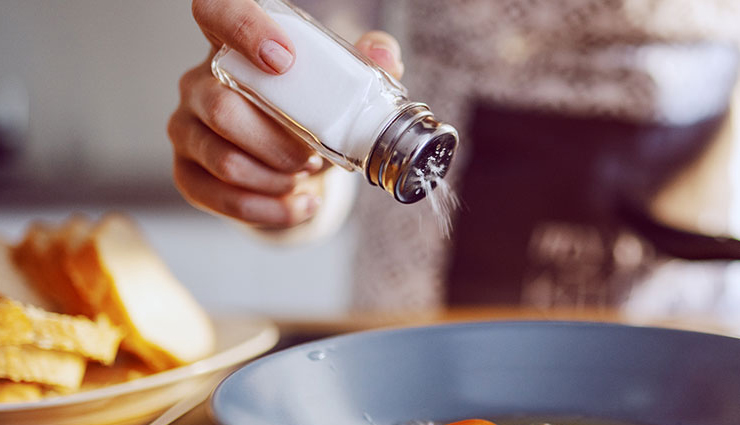- Home›
- Healthy Living›
- 6 Tips To Increase Sodium Levels In The Elderly People
6 Tips To Increase Sodium Levels In The Elderly People
By: Priyanka Maheshwari Sat, 29 July 2023 8:37:27

As individuals age, their bodies undergo various physiological changes, including alterations in their metabolism, organ function, and overall health status. One critical aspect that needs careful consideration in elderly individuals is their sodium levels. Sodium is an essential mineral that plays a vital role in maintaining fluid balance, nerve function, and muscle contractions. However, excessive or insufficient sodium levels can lead to significant health issues, especially in the elderly population.
In this context, it is essential to understand how sodium levels can affect elderly individuals differently compared to younger adults. As people age, their bodies may become more susceptible to imbalances in sodium levels, which can be influenced by various factors such as diet, medication use, and overall health conditions. High sodium intake can lead to hypertension (high blood pressure), while low sodium levels can result in hyponatremia, which may cause confusion, weakness, and other severe complications.
Managing sodium levels in the elderly becomes even more crucial due to their increased vulnerability to certain health conditions. As a result, healthcare professionals, caregivers, and family members must be aware of the potential risks associated with sodium imbalances in this population. By implementing appropriate dietary strategies, monitoring medication use, and recognizing the signs of sodium-related issues, it is possible to improve the overall well-being and quality of life for elderly individuals.
Sodium, an indispensable electrolyte essential for our body's proper functioning, plays a crucial role in maintaining water balance and supporting vital functions such as neuron activity, stable blood pressure, and effective muscle performance.
For elderly individuals, maintaining optimal sodium levels is especially important due to these reasons. Any disruption in the body's sodium balance can lead to a medical condition known as hyponatremia.
Hyponatremia occurs when the blood lacks an adequate amount of sodium, resulting from an imbalance between sodium and water. This means that the blood can either have an excess of water or insufficient sodium.
Studies have established that the normal range for sodium levels is typically between 135 to 145 milliequivalents per liter. When the sodium level falls below 135 mEq/L, hyponatremia develops.

Symptoms of Low Sodium Levels in the Elderly
Low sodium levels, or hyponatremia, can have various symptoms in elderly individuals. The severity of these symptoms may vary depending on the extent of the sodium imbalance and the overall health of the individual. It is essential to recognize and address these symptoms promptly as hyponatremia can lead to serious complications if left untreated. Some common symptoms of low sodium levels in the elderly include:
- Confusion and Disorientation: Seniors with hyponatremia may experience confusion, difficulty concentrating, and memory problems. They may have trouble recalling recent events or become disoriented in familiar surroundings.
- Fatigue and Weakness: Low sodium levels can cause weakness and overall fatigue in elderly individuals. They may feel lethargic and find it challenging to perform daily activities.
- Nausea and Vomiting: Hyponatremia can lead to gastrointestinal symptoms such as nausea and vomiting, which can further contribute to dehydration and exacerbate the electrolyte imbalance.
- Headache: Elderly people with low sodium levels may experience persistent headaches that can range from mild to severe.
- Muscle Cramps and Twitching: Inadequate sodium levels may result in muscle cramps, spasms, or twitching, leading to discomfort and difficulty in movement.
- Unsteadiness and Falls: Hyponatremia can affect the nervous system, leading to unsteadiness and an increased risk of falls in the elderly.
- Seizures: In severe cases of hyponatremia, elderly individuals may experience seizures, which can be life-threatening.
- Changes in Mood: Sodium imbalances can impact mood, leading to irritability, sadness, or mood swings in the elderly.
- Loss of Appetite: Low sodium levels may cause a decrease in appetite, leading to reduced food and fluid intake, which can worsen the condition.
- Swelling: In some cases, hyponatremia can lead to fluid retention and swelling, particularly in the legs and ankles.
It is crucial to seek immediate medical attention if an elderly person shows any of these symptoms. Hyponatremia requires proper diagnosis and management by healthcare professionals to address the underlying cause and restore sodium levels to a safe range.
How to Increase Sodium Levels in Elderly People
Increasing sodium levels in elderly people should be approached with caution, as excessive sodium intake can lead to health issues, especially for those with certain medical conditions like hypertension or heart problems. However, if a healthcare professional determines that an elderly individual's sodium levels are low and need to be raised, the following strategies can be considered:

- Dietary Changes: Adding moderate amounts of sodium-rich foods to the diet can help increase sodium levels. These foods include table salt, canned soups, salty snacks, processed meats, and certain types of cheese. However, it's essential to balance sodium intake with other nutrients and adhere to any dietary restrictions or recommendations provided by healthcare professionals.

- Oral Rehydration Solutions: For mild cases of hyponatremia, oral rehydration solutions that contain electrolytes, including sodium, can help restore the balance. These solutions are available over-the-counter at pharmacies and can be administered following the recommended dosage.
- Intravenous (IV) Fluids: In severe cases of hyponatremia or when oral intake is not possible, healthcare professionals may administer IV fluids containing sodium to rapidly increase sodium levels.
- Medication Adjustment: Some medications, such as diuretics or certain antidepressants, can contribute to low sodium levels. In some cases, healthcare professionals may adjust medication dosages or prescribe alternatives to address this issue.
- Limit Fluid Intake: If hyponatremia is due to an excessive intake of fluids, restricting fluid intake, especially in cases of dilutional hyponatremia, can help increase sodium concentration in the blood.
- Addressing Underlying Causes: Treating any underlying medical conditions or factors contributing to hyponatremia is essential to prevent further sodium depletion.





